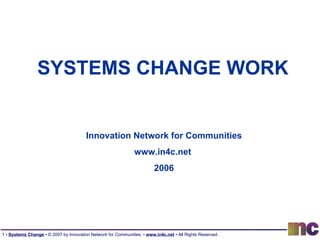Systems Change Work
•Als PPT, PDF herunterladen•
4 gefällt mir•1,539 views
Frameworks for changing large systems with small resources.
Melden
Teilen
Melden
Teilen

Empfohlen
Empfohlen
This presentation was taken from The Luxury Marketing Council, The Importance of Good Listening and Conversation event, held at The Wick.
Presentation was completed by Judith Glaser of The Creating We Institute.The Creating We Institute, The Importance of Good Listening and Conversation ...

The Creating We Institute, The Importance of Good Listening and Conversation ...Luxury Marketing Council of Connecticut-Hudson Valley
Weitere ähnliche Inhalte
Was ist angesagt?
This presentation was taken from The Luxury Marketing Council, The Importance of Good Listening and Conversation event, held at The Wick.
Presentation was completed by Judith Glaser of The Creating We Institute.The Creating We Institute, The Importance of Good Listening and Conversation ...

The Creating We Institute, The Importance of Good Listening and Conversation ...Luxury Marketing Council of Connecticut-Hudson Valley
Was ist angesagt? (20)
The Creating We Institute, The Importance of Good Listening and Conversation ...

The Creating We Institute, The Importance of Good Listening and Conversation ...
Andere mochten auch
Andere mochten auch (11)
Innovation Framework For Manufacturing (With Addendum)

Innovation Framework For Manufacturing (With Addendum)
Ähnlich wie Systems Change Work
Ähnlich wie Systems Change Work (20)
Systems Thinking in Public Health for Continuous Quality Improvement

Systems Thinking in Public Health for Continuous Quality Improvement
Analysing and documenting innovation and innovation processes

Analysing and documenting innovation and innovation processes
How do we navigate uncertainty while trying to shift the systems we work in

How do we navigate uncertainty while trying to shift the systems we work in
RECODE Collaborate Webinar: Designing your campus change strategy,

RECODE Collaborate Webinar: Designing your campus change strategy,
GreenBiz 19 Workshop Slides: The School of Systems Change

GreenBiz 19 Workshop Slides: The School of Systems Change
Foundation of Organization Design (MGMT673)Reading Materia.docx

Foundation of Organization Design (MGMT673)Reading Materia.docx
Systems Change Work
- 1. SYSTEMS CHANGE WORK Innovation Network for Communities www.in4c.net 2006
- 2. The INC Mission is to develop and spread scalable innovations that transform the performance of community systems. www.in4c.net Pete Plastrik 231-448-3169 [email_address] John Cleveland 616-240-9751 [email_address]
- 9. Buttons And Threads – The “Tipping Point” Ratio of Threads to Buttons Level of Connectivity “ Phase change” (small input creates large output)
- 10. Anatomy of A System (with School Examples) AGENTS (Players/Actors/Nodes): The entities who make decisions that affect the shape of the system and its outcome. (In schools = staff; students; parents; buildings; departments; the Board; employers; legislature; Governor;etc.) RULES (Paradigms/Mental Models): The criteria the agents/players use to make decisions about how to act. (In schools = assumptions about learning and assumptions about healthy organizations.) STRUCTURES (Connections/Paths/Links/Relationships): The structures that create opportunities for the agents/players to interact with each other. (In schools = classrooms; organizational structures; parent/teacher conferences; PTA’s; Board meetings; etc.) FEEDBACK LOOPS (Information/Indicators/Incentives/Consequences): Information the agents/players use to decide when to act on their rules. (In schools = student performance; staff evaluations; budget information; truancy; community satisfaction; Board elections; millages; etc.)
- 15. Five Kinds of Strategies for Spreading Practice ( Step 7: “Scale Up” ) Strategy Description Developing Public Policies Persuading government bodies to revise, adopt and implement laws, regulations, investments or services that advance practices. Fostering Communities of Practice Building learning networks among individuals and organizations that can voluntarily develop, adopt and rapidly spread new tools and practices. Influencing Markets Creating incentives for business, organizations, and consumers to make economic choices that support desired outcomes. Changing Power Relationships Mobilizing low-income people and communities to secure representation and voice in public, private, civic and cultural decision-making processes that affect their lives. Promoting Social Learning Using educational processes to provide large numbers of individuals with information that influences their personal behaviors.
- 16. Different Ways to “Get to Scale” ( Step 7: “Scale Up” ) Developing Public Policies Fostering Communities of Practice Influence Markets Change Power Relationships Promoting Public Learning Scaling Mechanism Government decisions Collaborative learning Value exchange Political power Persuasive information Form of Innovation Policies (mandates, regulations, investments) New, improved practices Products, services and enterprises New players in governance positions Information, messages and experiences Scale Target Wide range: targeted constituencies to general public Organizations sharing similar concerns Size of the market Political jurisdictions Targeted audience (with key characteristics in common) Constraints Resistance of opponents Ineffective enforcement or implementation Organizations may lack time, resources, readiness for learning processes Consumers may not have purchasing power. Products may not attract investment. Established interests will vehemently defend their turf Audience may lack access to information or doubt credibility of messenger Audience may not be empowered to act on the information